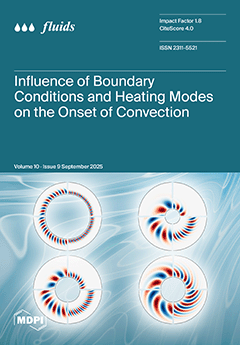Open AccessArticle
Experimental and Numerical Analysis of Nozzle-Induced Cavitating Jets: Optical Instrumentation, Pressure Fluctuations and Anisotropic Turbulence Modeling
by
Luís Gustavo Macêdo West, André Jackson Ramos Simões, Leandro do Rozário Teixeira, Igor Silva Moreira dos Anjos, Antônio Samuel Bacelar de Freitas Devesa, Lucas Ramalho Oliveira, Juliane Grasiela de Carvalho Gomes, Leonardo Rafael Teixeira Cotrim Gomes, Lucas Gomes Pereira, Luiz Carlos Simões Soares Junior, Germano Pinto Guedes, Geydison Gonzaga Demetino, Marcus Vinícius Santos da Silva, Vitor Leão Filardi, Vitor Pinheiro Ferreira, André Luiz Andrade Simões, Luciano Matos Queiroz and Iuri Muniz Pepe
Cited by 1 | Viewed by 816
Abstract
Cavitation has been widely explored to enhance physical and chemical processes across various applications. This study aimed to model the key characteristics of a cavitation jet, induced by a triangular-orifice nozzle, using both experimental and numerical methods. Optical instrumentation, a pressure transducer and
[...] Read more.
Cavitation has been widely explored to enhance physical and chemical processes across various applications. This study aimed to model the key characteristics of a cavitation jet, induced by a triangular-orifice nozzle, using both experimental and numerical methods. Optical instrumentation, a pressure transducer and the Reynolds-Averaged Navier–Stokes (RANS) equations were employed. Optical instrumentation and high-speed photography detected the two-phase flow generated by water vaporization, revealing a mean decay pattern. Irradiance fluctuations and photographic evidence provided results about the light transmission dynamics through cavitating jets. Pressure fluctuations exhibited similar growth and decay, supporting optical instrumentation as a viable method for assessing cavitation intensity. Experimental data showed a strong relationship between irradiance and flow rate (R
2 = 0.998). This enabled the correlation of the standard deviation of instantaneous pressure measurements and normalized flow rate (R
2 = 0.977). Furthermore, vapor volume fraction and normalized flow rate reached a correlation coefficient of 0.999. On the simulation side, the SSG-RSM turbulence mode showed better agreement with experimental data, with relative deviations ranging from 2.1% to 6.6%. The numerical results suggest that vapor jet length is related to vapor fraction through a power law, enabling the development of new equations. These results demonstrated that anisotropic turbulence modeling is essential to reproduce experimental observations compared to mean flow properties. Based on the agreement between the numerical model and the experimental data for mean flow quantities, a formulation is proposed to estimate the jet length originating from the nozzle, offering a predictive approach for cavitating jet behavior.
Full article
►▼
Show Figures





